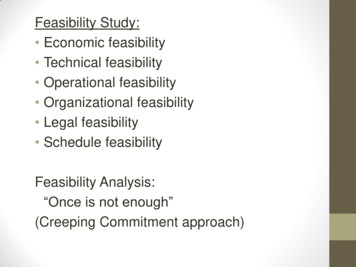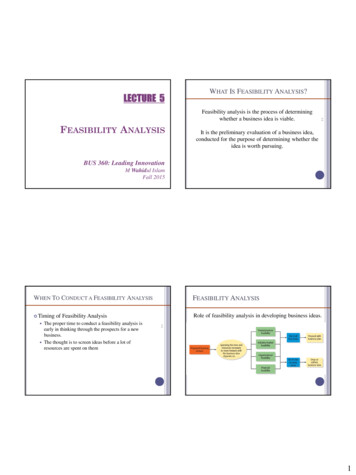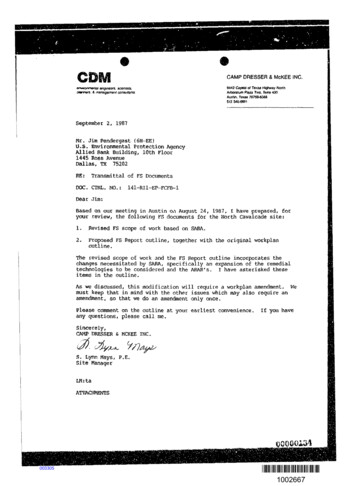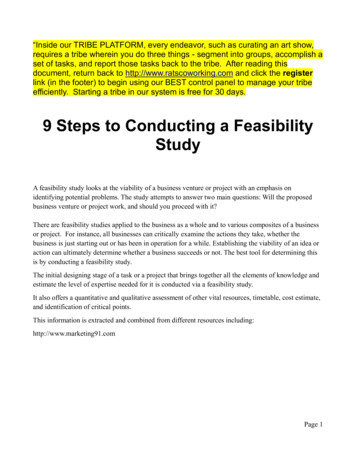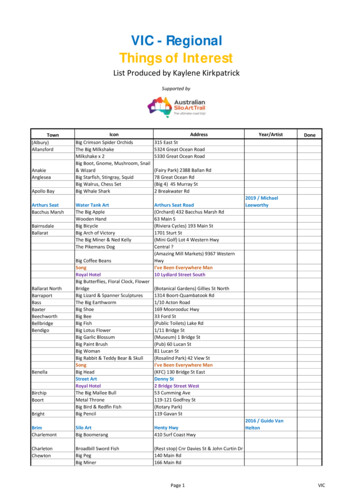
Transcription
XThe feasibility of using big datain anticipating and matchingskills needs
The feasibility of usingbig data in anticipating andmatching skills needsILO Geneva
iiCopyright International Labour Organization 2020First published 2020Publications of the International Labour Office enjoy copyright under Protocol 2 of the Universal Copyright Convention.Nevertheless, short excerpts from them may be reproduced without authorization, on condition that the source is indicated. For rights of reproduction or translation, application should be made to ILO Publications (Rights and Licensing),International Labour Office, CH-1211 Geneva 22, Switzerland, or by email: rights@ilo.org. The International Labour Officewelcomes such applications.Libraries, institutions and other users registered with a reproduction rights organization may make copies in accordancewith the licences issued to them for this purpose. Visit www.ifrro.org to find the reproduction rights organization in yourcountry.The feasibility of using big data in anticipating and matching skills needs – International Labour Office – Geneva:ILO, 2020ISBN 978-92-2-032855-2 (print)ISBN 978-92-2-032854-5 (web PDF)The designations employed in ILO publications, which are in conformity with United Nations practice, and the presentation of material therein do not imply the expression of any opinion whatsoever on the part of the International LabourOffice concerning the legal Status of any country, area or territory or of its authorities, or concerning the delimitationof its frontiers.The responsibility for opinions expressed in signed articles, Studies and other contributions reSts solely with their authors,and publication does not conStitute an endorsement by the International Labour Office of the opinions expressed therein.Reference to names of firms and commercial products and processes does not imply their endorsement by theInternational Labour Office, and any failure to mention a particular firm, commercial product or process is not a signof disapproval.Information on ILO publications and digital products can be found at: www.ilo.org/publns.Produced by the Publications Production Unit (PRODOC) of the ILO.Graphic and typographic design, layout and composition,printing, electronic publishing and distribution.The ILO endeavours to use paper sourced from forests managedin an environmentally sustainable and socially responsible manner.Code: JMB-REP
iiiEditors and authorsEditorsAna PodjaninInternational Labour Office (ILO)Olga Strietska-IlinaInternational Labour Office (ILO)AuthorsIntroduction: Ana Podjanin, ILOSection 1.1: Konstantinos Pouliakas and Jasper Van Loo, CedefopSection 1.2: Eduarda Castel-Branco, European Training Foundation (ETF)Section 1.3: Fabio Mercorio, University of Milan – BicoccaSection 1.4: Stefan Winzenried, Janzz TechnologySection 2.1: Claudia Plaimauer, 3sSection 2.2: Renier Van Gelooven, SBB – Foundation for Cooperation on Vocational Education, Trainingand the Labour MarketSection 2.3: Gábor Kismihók, Leibniz Information Centre for Science and Technology University Library (TIB)Section 2.4: Labour Market Information Council, Canada, Employment and Social DevelopmentCanada and Statistics Canada (presented by Tony Bonen, LMIC)Section 2.5: Andy Durman, EMSI UKSection 3.1: Carlos Ospino Hernández, Inter-American Development BankSection 3.2: Sukriti, LinkedIn IndiaSection 3.3: Hiromichi Katayama, UNESCOSection 4.1: Inna GrinisSection 4.2: Julia Nania, Hal Bonella, Dan Restuccia and Bledi Taska, Burning Glass TechnologiesSection 4.3: Ana Podjanin, Olga Strietska-Ilina and Bolormaa Tumurchudur-Klok, ILOConclusions: Cornelius Gregg, Olga Strietska-Ilina, ILO
vForewordMismatches between the skills offered and those required on the job market continue to be high on thepolicy agenda of both developed and developing countries across the world. Digitalization and technologicaldisruptions are changing skills demand very fast, turning the task of identifying skills needs into the pursuitof a fast-moving target that is hard, if not impossible, to hit. At the same time, uncertainty and disruptionraise the bar of expectation in predicting the skills required by the jobs of the future even higher. Thecurrent publication is based on a discussion among experts about how big data analytics might be usedto help anticipate skills needs better and faster. This discussion took place at an ILO workshop in Geneva,Switzerland, on 19–20 September 2019, just a couple of months before the beginning of the COVID-19outbreak. At the time of publication, we are already seeing unprecedented disruption in the labour market,along with unprecedented levels of public expectation for rapid answers to complex questions: what skillsare needed, what reskilling measures deserve budgetary allocations, which active labour market measuresshould be prioritized and how to advise those who have lost their jobs about possible career prospects.The traditional methods of skills needs anticipation and matching involve reliance on either quantitativeanalysis or qualitative research. Quantitative approaches typically use proxies for the measurement ofskills, such as occupations, qualifications and levels or types of education. Such proxies provide usefulinformation but are not sufficiently informative about the specific skills and competencies needed on thelabour market. Without this extra level of information, skills remain hard to pin down in policy-making.Qualitative approaches certainly fit the purpose better, allowing us to identify specific skills and competencyneeds at regional or sectoral level, or for specific occupations and qualifications. However, they are fairlytime-consuming and require significant resources; also, given the speed at which labour markets arechanging, they run the risk of producing information that is obsolete before it can be used. This is whyresearchers and policy-makers are looking for other sources of information that will help to address theproblem more efficiently.The increasing use of the Internet for publishing job vacancies offers an incredibly rich source of data.Namely, it allows us to access in real time information on current skills demand, captured through jobdescriptions. Since the information is already there, its use is also efficient in terms of cost. However, the datafrom this source lacks structure, suffers from duplications and lack of representativeness, needs cleaningand quality checking, and is subject to many other potential problems, including data privacy issues thatstand in the way of its effective use. In developing countries, an additional limitation is a limited reachof online vacancies due to poor connectivity and a large share of informal jobs. Nevertheless, online jobvacancies and other types of big data analytics have great potential to contribute to a better understandingof labour markets, especially if complemented by more traditional sources of information.This publication is composed of the contributions to the ILO workshop on the use of big data for skills anticipation and matching. The aim of this workshop was to share good practices and experiences, and identifyto what extent these existing methods and approaches can be used and adapted for developing countries.Srinivas ReddyChief, Skills and Employability Branch,ILO Employment Policy Department
viiAcknowledgementsThis report is based on the inputs received from participants during the workshop “Can we use big data forskills anticipation and matching?” held in Geneva on 19–20 September 2019, and we would like to thankeveryone who took part in this event and subsequently provided contributions to this publication. We wouldespecially like to thank Mr Srinivas Reddy, the Chief of the Skills and Employability Branch of the EmploymentPolicy Department of the ILO, for his continued support for innovative solutions to forward-looking skillsanalysis, including big data analytics. We also would like particularly to acknowledge the support of the jointdevelopment cooperation programme of the ILO and the Norwegian Ministry of Foreign Affairs, “SKILL-UP– Upgrading skills for the changing world of work”, and its coordinator Sergio Iriarte Quezada.The workshop itself would not have happened without the involvement and the support of our ILO colleagues, and for this we owe thanks to Ángela Ayala Martínez, Serena dell’Agli, Axelle de Miller, MilagrosLazo Castro, Tahmina Mahmud, Louise Mbabazi-Kamina and Bolormaa Tumurchudur-Klok.Useful comments and suggestions for this report were provided by Bolormaa Tumurchudur-Klok andTahmina Mahmud of the ILO. Gillian Somerscales carried out language editing.
ixContentsEditors and authors iiiForeword vAcknowledgements viiList of figures xiiList of tables xiiiList of boxes xiiiList of abbreviations xvIntroduction 11. Conceptual and technical aspects of knowledge-sharing on the usage of big data 31.1.Cedefop and the analysis of European online job vacancies 41.1.1. Introduction 41.1.2. Analysing OJVs: Opportunities and challenges 41.1.3. The online labour market in the EU 51.1.4. Collecting and analysing online job vacancies 61.1.5. Online dissemination and future work 81.2. The European Training Foundation and big data for labour market intelligence:Shaping, applying and sustaining knowledge 101.2.1. Introduction 101.2.2. Big data for LMI: The ETF project 101.2.3. Questions and reflections 131.2.4. A methodology for turning big data into LMI 141.3. Can we use big data for skills anticipation and matching? The case of online job vacancies 171.3.1. Quo vadis labour market? 171.3.2. LMI and big data: Current work and future potential 181.3.3. Identifying new (potential) emerging occupations 181.3.4. Hard/soft/digital skills rates 211.3.5. Further research directions 231.4. From big data to smart data: The misconception that big data yields useful predictionson skills 241.4.1. Introduction 241.4.2. Over ten years of unique experience with occupational big data 251.4.3. The importance and definition of skills and competencies: A brief examination 261.4.4 Illustrative examples 291.4.5. Conclusion 32
xThe feasibility of using big data in anticipating and matching skills needs2. Using big data to assess and meet skills needs: Learning from advancedcountries’ experience 352.1. Using big data and AI for identifying LMI in Austria 362.1.1. Preliminary experience with big data and AI methods 362.1.2. Using big data analysis to develop labour market taxonomies: The caseof the Austrian PES’ skills taxonomy 372.2. The use of big data for skills anticipation and matching in the Netherlands 442.2.1. Introduction to SBB 442.2.2. LMI and the information pyramid 442.2.3. Conclusions 492.3. Lessons learned from selected studies on education–labour market matching 502.3.1. Text mining in organizational research 502.3.2. Text classification for organizational researchers: A tutorial 502.3.3. Automatic extraction of nursing tasks from OJVs 502.3.4. Big (data) insights into what employees do: A comparison between task inventoryand text-mining job analysis methods 512.3.5. Survey vs scraped data: Comparing time-series properties of web and surveyvacancy data 512.3.6. Combining learning analytics with job market intelligence to support learningat the workplace 512.4. Bridging the gap between skills and occupations: Identifying the skills associatedwith Canada’s National Occupational Classification 522.4.1. Overview, rationale and objective 522.4.2. Introduction 522.4.3. Background 532.4.4. A Canadian skills and competencies taxonomy 532.4.5. Connecting the skills and competencies taxonomy to the NOC 552.4.6. The way forward 58Appendix: ESDC’s skills and competencies taxonomy 582.5. Bringing traditional sense to the big data craze: Emsi UK 612.5.1. Introducing Emsi 612.5.2. The “why” and “how” of Emsi LMI 612.5.3. Some observations 663. Use of big data by emerging and developing economies 673.1. Viewing changes in skills demand in Latin America and the Caribbean through LinkedIn 683.1.1. New data sources to meet new challenges 683.1.2. Using LinkedIn data to investigate changes in skills demand 683.1.3. Using LinkedIn to explore trends in Latin America and the Caribbean 69
xiContents3.1.4. What do new data sources tell us about emerging skills in Latin Americaand the Caribbean? 703.1.5. What options does this research open up for policy-makers and workers? 703.2. Using the LinkedIn Economic Graph in India 723.2.1. Introduction to the Economic Graph 723.2.2. Insights from developing/emerging economies on the future of work: India 723.3. Using real-time big data to inform TVET policies and strategies: The case of Myanmar 743.3.1. The data challenge in UNESCO’s work to support national TVET policies 743.3.2. Supplementing traditional LMI with big data to generate more useful knowledge 744. Connecting the dots: Combining big data and other types of data to meet specificanalytical demands 774.1. The STEM requirements of “non-STEM” jobs: Evidence from UK online vacancy postings 784.2. Using real-time LMI to measure digital transformation 814.3. Sharing experiences in using big data in combination with other methods 834.3.1. Challenges for developing countries and beyond 834.3.2. Complementing different data sources: Skills for a greener future 844.3.3. Validating and complementing results of qualitative sectoral studies on Skillsfor Trade and Economic Diversification (STED) 884.3.4. Adding granularity and “realtimeliness” by combining labour force survey dataand big data 904.3.5. Conclusion 92Conclusion 94References 96
xiiThe feasibility of using big data in anticipating and matching skills needsList of figuresX Figure 1.1.Proportions of job vacancies published online in the EU: Assessmentby country experts, 2017 (%) X Figure 1.2. A summary of the OJV data collection and production process X Figure 1.3. Disseminating information on OJVs: A sample dashboard from Cedefop’sSkills OVATE 679X Figure 1.4. The ETF initiative on big data for LMI: The four main elements 11X Figure 1.5. Data flow, from data collection to results presentation 12X Figure 1.6. Main features of a network of experts to develop big data for LMI 12X Figure 1.7.14The KDD process, showing the “big data Vs” involved in each step X Figure 1.8. Detecting new (potential) emerging occupations through AI 19X Figure 1.9. Distribution of ICT-related OJVs in Italy in 2018, classified using the e-CF standard 20X Figure 1.10. Analysis of DSR by sector (level 1) 21X Figure 1.11. Analysis of DSR by digital skills (level 2) 22X Figure 1.12. Analysis of DSR by occupation and elementary ESCO skills (level 3) 22X Figure 1.13. Long-term weather forecast for Switzerland, summer 2019, usingcomprehensive big data models, compared to actual measured temperatures X Figure 1.14. Typical, current example from the skilling, upskilling and training area,showing further dimensions of skill definitions and their mapping/classification 2527X Figure 1.15. Typical relation of skills and professions in ESCO or O*NET 28X Figure 1.16. Various examples of job advertisements 29X Figure 2.1. Main characteristics of the Austrian PES’ two labour market taxonomies 37X Figure 2.2. Presentation of “skills” in occupational profiles: An example 38X Figure 2.3. Correlation between number of characters in term and number of occurrences(excluding 0 occurrences) 41X Figure 2.4. The information pyramid 45X Figure 2.5. Numbers of Internet searches for “big data” and “education”, 2008–15 46X Figure 2.6. Sample screenshot from KiesMBO (TVET portal for study and career choice) 48X Figure 2.7. ESDC skills and competencies taxonomy framework 54X Figure 3.1. Demand for top 20 job titles in Myanmar in 2019 75X Figure 3.2. Skills demand by occupation in Myanmar 76X Figure 4.1. The geographical location of STEM vacancies posted in the UK, 2015:(a) % of STEM jobs in each county; (b) STEM density of each county 79
xiiiContentsX Figure 4.2. Jobs created and destroyed in the energy transition scenario by occupation,to 2030: Occupations with the highest reallocation of jobs across industries X Figure 4.3. Transition paths for power plant operators (ISCO 3131) under the energysustainability scenario X Figure 4.4. Overlap of skills for science and engineering associate professionalsin declining and growing industries (energy sustainability scenario) X Figure 4.5. Manufacturing employment in four US states and in all US: Changebetween 2000 and 2018 (%; 2000 100%) X Figure 4.6. Top 30 skills in shortage, related to high-skilled occupations, Uruguay, 2017 8586878991List of tablesX Table 1.1.Advantages and disadvantages of using OJVs for analysis of skills needs X Table 1.2.Typical forecasts of general “top skills”, as published regularly by LinkedInand the World Economic Forum 26X Table 2.1.Longer but frequently occurring taxonomy terms 41X Table 2.2.Opportunities and threats in the potential use of big data, as seenby the Netherlands Ministry of Education 47X Table 2.3.Key criteria for evaluating the mapping project 57X Table 2.4.Sources for ESDC’s skills and competencies taxonomy 59X Box 1.1.Which ten skills are now mentioned more frequently? 32X Box 2.1.Skills measurement: Caveats and considerations 53X Box 2.2.Digital skills 565List of boxes
xvList of abbreviationsAIartificial intelligenceAPIapplication programming interfaceCedefopEuropean Centre for the Development of Vocational TrainingDSRdigital skills ratee-CFEuropean e-Competence FrameworkESCOEuropean skills/competencies, qualifications and occupations frameworkESDCEmployment and Social Development CanadaETFEuropean Training FoundationETLextract, transform, loadEUEuropean UnionHRhuman resourcesICTinformation and communications technology/iesIADBInter-American Development BankISCEDInternational Standard Classification of EducationISCOInternational Standard Classification of OccupationsISICInternational Standard Industrial ClassificationJMIJob Market Intelligence (Cedefop)KDDknowledge discovery in databasesLAlearning analyticsLMIlabour market informationLMICLabour Market Information Council (Canada)NACENomenclature statistique des activités économiques dans la Communautéeuropéenne (statistical classification of economic activities in the EU)NLPnatural language processingNOCNational Occupational Classification (Canada)NSOnational statistical officeNUTSNomenclature of Territorial Units for StatisticsOECDOrganisation for Economic Co-operation and DevelopmentOVATEOnline Vacancy Analysis Tool for EuropeOJVsonline job vacanciesp.a.per annumPESpublic employment service(s)SBBFoundation for Cooperation on Vocational Education, Training and the Labour Market(Netherlands)
xviThe feasibility of using big data in anticipating and matching skills needsSOCStandard Occupational Classification (US/UK)STCStatistics CanadaSTEMscience, technology, engineering and mathematicsTVETtechnical and vocational education and trainingUNESCOUnited Nations Educational, Scientific and Cultural OrganizationVETvocational education and trainingWEFWorld Economic Forum
1IntroductionIn dynamic and constantly changing labour markets, identifying skills needs is a significant challenge.Imbalances in the labour market, reflected in difficulties businesses face in sourcing the skills they need, ahigh incidence of skills mismatches, and significant unemployment or underemployment, especially amongyouth, are observed in most countries, albeit in different forms and to different extents. In view of the rapidlyevolving labour market, there is a need to address not only currently observed mismatches, but also thosethat could potentially appear in the future, if the labour force is not adequately prepared to meet futureneeds. In order to tackle these issues, policy-makers, employers, workers, providers of education and training, and students all need timely and accurate information about demand for skills on the labour market.Traditionally, policy-makers have used information both from official labour force surveys and from othersurveys to provide quantitative information on labour market needs. While these sources are very rich ininformation and can be nationally representative, they can also have significant limitations. In less advancedeconomies they may not be conducted on a regular basis because of their high cost. More generally, theindicators they provide, such as occupation or qualifications, are only proxies for understanding actual skillsrequirements, and may not by themselves convey enough specific information to reliably guide action. Theskills needs associated with particular occupations vary with context, and change over time.Emerging new sources of data on skills have the potential to provide real-time and detailed informationon skills needs in a cost-effective way. Technological advances, digitalization and Internet platforms havemade it possible to collect very large, and rich, data sets, or so-called “big data”, for many purposes. Dataon the content of job advertisements has been collected systematically from online job postings in a rangeof countries, contributing to the generation of huge data sets containing detailed information on therequirements advertised. Information typically recorded includes the specific skills needs stipulated andskills-related indicators included in advertisements, such as job titles, along with requirements for qualifications, certifications and experience, as well as other information about each vacancy such as the employer,the economic sector, the occupational category and the geographic location of the post advertised. Dataderived from online job postings can be collected in real time and, in contrast with data from surveys thatrequire time for processing before publication, can be used almost immediately. This immediacy also offersan advantage over skills requirements taxonomies, which usually take a considerable amount of researchand analysis, along with time to be produced and regularly updated.The richness of information featured in online job vacancies data sets has attracted considerable attention,and has underpinned many publications within both academia and international organizations.However, it is important to take into account the limitations associated with using vacancy data derivedfrom the Internet as a basis for labour market information (LMI). The sample of vacancies collected may notbe representative of all online-advertised vacancies, and is unlikely to be representative of all job vacanciesbecause of differences in recruitment practices by occupation and industry. Higher-level skills are morelikely to be advertised online, especially in less advanced economies. Online job advertisements chieflycover the formal economy, so skills needed for informal employment are likely to be under-represented.Moreover, while skills requirements noted in online job listings provide a window on the landscape ofdetailed skills requirements, they do not provide full listings of skills required in the manner of an occupational competency standard. There are no consistent standards stipulating what skills should be includedin an advertisement. Many skills may be omitted because they are taken for granted by the recruiter, whilethose included may have been identified by the employer as salient because they differentiate the job onoffer from similar jobs. Other potential drawbacks inherent in real-time data arise from a lack of structure,imperfect information and measurement errors, especially related to duplicate observations, and advertisements in which the number of jobs available is unspecified. Legal and regulatory matters may also bean issue, especially in relation to data privacy, which also poses challenges to extending the use of big datain labour market analysis.
2The feasibility of using big data in anticipating and matching skills needsAnalyses of vacancy data do not constitute a direct substitute for the main existing sources of labourmarket data. They provide flow-related measures inclusive of churn, whereas conventional labour marketanalysis is often based on measures of stock or on direct measures of flow that seek to filter out churn.It remains to be seen to what extent vacancy-based big data analysis will be mainstreamed into nationalskills anticipation systems, to what extent it will be used as a complement to or a substitute for other partsof these systems, and to what extent it could provide a fast track into skills anticipation for less developedcountries that do not have established systems. The future role of big data in skills anticipation beyond thevacancies data domain also remains unclear.This publication collects together the contributions presented during the ILO workshop “Can we use bigdata for skills anticipation and matching?”, which took place on 19–20 September 2019 at ILO headquartersin Geneva, Switzerland. Discussions during the workshop considered the feasibility of using big data in thecontext of skills anticipation and matching, and both the potential and the limitations of big data in skillsanalysis. Participants had the opportunity to offer suggestions on how to advance the agenda in this area,to share good practices and to suggest solutions to commonly found challenges. While these methods ofdata analysis have already been extensively used in advanced economies, a particularly important focusof the discussions was how they can best be deployed in developing economies.The first chapter of this publication presents the contributions related to the more conceptual and technicalaspects of using real-time data in skills analysis. Following these reflections, the second chapter puts together best practices and experiences from advanced economies. Reflecting the importance of discussing thepotential of the use of online job vacancy data in the context of developing economies, the third chapteroffers insights from analyses carried out across Latin America and Asia. The fourth chapter shifts the focusaway from specific country contexts towards new approaches, such as combinations of big data with othersources. It also opens the way for further discussion in relation to the interpretation of this type of data.
The feasibility of using big data in anticipating and matching skills needs1. Conceptual and technical aspects of knowledge-sharing on the usage of big data1Conceptualand technical aspectsof knowledge-sharingon the usage of big dataThis chapter discusses conceptual and technical aspects of big dataanalytics, and the related challenges and opportunities for improving LMIand delivering real-time and detailed skills demand analysis. It looksinto the potential of the use of online job vacancies for skills needsanticipation and matching.3
41.1. Cedefop and the analysis of European onlinejob vacanciesJasper Van Loo and Konstantinos Pouliakas1.1.1. IntroductionEU decision-makers responsible for education and training, labour markets and/or skills need timely andreliable skills intelligence to support them in developing policies to better match skills with labour marketneeds. In the light of rapidly changing labour market needs, skills intelligence is crucial to designing, reforming and “future-proofing” education and training programmes. Surveys of employers, workers, graduatesor the wider population can be, and have been, used to collect representative information on skills. Butthey are typically costly and time-consuming to implement, requiring substantial conceptual developmentin advance, and high response rates if they are to yield representative findings. Other “traditional” methodssuch as occupational and skills forecasts provide useful insights into medium- and long-term labour markettrends; but, owing to the use of proxies for skills demand, endogeneity issues and time-lags between datacollection and the generation of results, they are less suitable for prompt detection of employers’ changingskills needs.Since 2015, in line with its mandate to analyse labour market and skills trends in EU Member States, theEuropean Centre for the Development of Vocational Training (Cedefop) has been investigating how information on skills demand available in online job vacancies (OJVs) can be used to generate faster and moredetailed skills intelligence for the EU – as a complement to its other skills intelligence tools, namely theEuropean skills forecast, the European skills and jobs survey and the European skills index.1 A feasibility pilotstudy involving a limited number of countries, carried out in 2015, highlighted the potential for a pan-European online vacancy collection and analysis system to provide a detailed and unique set of policy-relevantinformation. In the past few years, Cedefop has focused on setting up the Skills OVATE (Online VacancyAnalysis Tool for Europe), a fully fledged system to collect and present indicators extracted from OJVs. Herewe outline the Cedefop approach and provide an overview of the experience so far.1.1.2. Analysing OJVs: Opportunities and challengesOJVs are a rich source of detailed information about skills and other job requirements that are difficult togather via traditional methods. Access to this information can help labour market actors better understandskills demand and its dynamics; enable individuals to make better career and skills development choices;support employers in developing or adjusting human resources (HR) policies; help policy-makers makemore informed decisions; and improve the targeting of employment services, guidance counsellors andlearning providers.OJV analysis can provide additional, detailed and timely insights on labour market trends, and enablesnew and emerging jobs and skills to be identified early. But OJV analysis does not replace other types oflabour market information and intelligence – it is in fact most powerful when combined with conventionalsources. And it is crucial to ack
2.sing big data to assess and meet skills needs: Learning from advanced U countries' experience 35 2.1.sing big data and AI for identifying LMI in Austria U 36 2.1.1. reliminary experience with big data and AI methods P 36 2.1.2. sing big data analysis to develop labour market taxonomies: The case U


